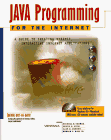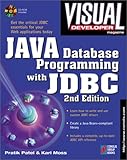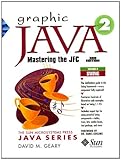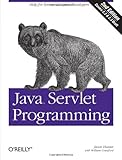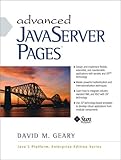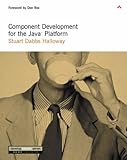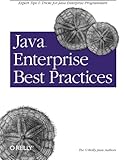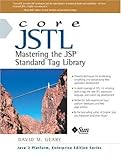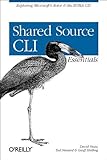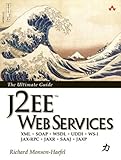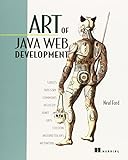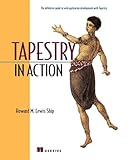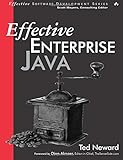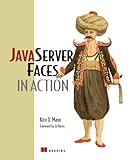NFJS Bookstore
-
You know about Extreme Programming, Agile cooperation, and continuous improvement, but did you know you can apply these to UI design? I'll show you how to make your end users happy all the time by applying what you already know about software development to the design and implementation of user interfaces. More and more, developers are being called upon to create user interfaces without designers. Extreme UI Design: The User is Always Right will show you how to use your well-honed programming skills to build measurably effective front ends.
It's all about usability, the software equivalent of flossing; you know you should do it, yet sometimes there just isn't time. For developers, there often isn't money to hire a designer. In tough times, developers who can design become essential, but most software engineers are schooled in algorithms and compilers and rarely in the intricacies of user interaction. This book is for all of you who find yourselves working on the front lines of software development and want to create an application that respects the maxim that all users are right.
- Discover best UI design practices for software engineers.
- Maximize usability right in your code with a few simple tools.
- Write software that works for the user!
What you'll learn
- Distinguish usability myth from reality
- Give users both what they want and what they need (these aren't the same)
- Use your application prototypes as test beds for usability
- Apply rigorous heuristics to measuring UI effectiveness
- See why CRAP is important to creating good interfaces
- Identify and avoid common UI anti-patterns
Who is this book for?
Looking to get an edge in today's workplace? Worried about being downsized? As companies look to cut expenses, the developer who can do more has a better chance of survival. If the UI team gets the axe, can you step in and help run a usability test or whack out a paper-based prototype? After reading this book, you'll be more valuable to your software development organization, you'll have a more complete toolbox, and you'll create applications that don't make your users yack .
This book is primarily aimed at software developers who are tasked with front-end development. Considering that almost all software has some kind of interface, it should appeal to a large audience. Depending on how the book is slanted, it should also interest the agile community.
-
Number of Videos: 4 hours - 23 lessons
Author: Ken Kousen
User Level: Beginner
Learn the advantages of using Groovy by itself and with existing Java projects. This video workshop takes you into the heart of this JVM language and shows you how Groovy can help increase your productivity through dynamic language features similar to those of Python, Ruby, and Smalltalk. Presenter and Java consultant Ken Kousen demonstrates how writing anything from a simple build script to a full scale application is much easier with Groovy than with Java. You’ll quickly learn how to add Groovy to your projects, and then explore the language through a host of examples and demonstrations. Once you complete this course, check out Ken’s other videos on the subject: Practical Groovy and Mastering Groovy. - Walk through Groovy’s basic data types. Use the “slashy” string syntax to define regular expressions. - Learn how operator overloading in the libraries simplifies your code - Control and customize all the natural defaults and autogenerated code in POGOs - Get demonstrations on using closures, and mixing Java and Groovy classes together - Know when and how to use Abstract Syntax Tree (AST) transformations - Parse and generate both XML and JSON - Access RESTful web services with ease Ken Kousen, President of Kousen IT, Inc., is a technical trainer, mentor, and consultant in all areas related to Java, specializing in Android, Spring, Hibernate/JPA, Groovy, and Grails. He is the author of Making Java Groovy (Manning) and the upcoming O’Reilly book, Gradle for Android.System Requirements:- Supported OS: [Mac Mountain Lion 10.8, Mac Lion 10.7, Mac Snow Leopard 10.6, Mac Leopard 10.5, Mac OS X, Macintosh]
- Processor: Any
- RAM: Any
- Hard Disk: 3GB
- Video Card: Any
Java Programming for the Internet: A Guide to Creating Dynamic, Interactive Internet Applications
by Pratik R. Patel, Alan D. Hudson, and Donald A. Ball
- Enables readers to master the Java programming language for internet applications while expanding the scope of online development, and the accompanying CD contains powerful sample applets and a copy of Netscape Navigator. Original. (Intermediate).
Java Database Programming with JDBC: Discover the Essentials for Developing Databases for Internet and Intranet Applications
by Pratik Patel and Karl Moss
- Java Database Programming with JDBC by Pratik Patel and Karl Moss is an updated edition of the authors' guide to the Java Database Connectivity (JDBC) standard for database programming under Java. While the original edition was perhaps geared more to those developers who needed to write their own JDBC database drivers, a fairly arduous task, this new edition provides more background information on database connectivity issues in Java and so will be even more useful to the casual or intermediate programmer. After a general introduction to JDBC and Structured Query Language (SQL), useful even to beginning programmers, the authors start by building a simple database-aware applet. New chapters on "servlets," Java components that run on the server-side and manage database operations, as well as a general discussion of middleware technologies are particularly good. Database access for JavaBean components (from Sun Microsystems JDK 1.1) is also discussed, including working code for two database-aware beans. This book also includes a quick introduction to the Java language (which will only be helpful if you already know C/C++), a detailed reference for the JDBC API, and a working example of a text-based JDBC driver. Though this book is still oriented toward the JDBC driver developer, the authors now provide enough general discussion of JDBC architectural issues to make it worthwhile to any programmer who needs to ramp up on what JDBC is and what capabilities it offers.
Java Developer's Reference
by Bryan Morgan, Michael Morrison, Michael T. Nygard, Dan Joshi, Tom Trinko, and Mike Cohn
- Java Professional Developer's Reference contains cross references and jump tables to help the reader locate the Java function. The reader is given a complete reference to the Java language installation, other language migrations and integration, the Java compiler, Java application development, the Java interpreter and applet viewer, HTML browers and more.
Visual Developer Java Database Programming with JDBC, 2nd Edition: The Essentials for Developing Databases for Internet and Intranet Applications
by Pratik Patel and Karl Moss
- Java Database Programming with JDBC by Pratik Patel and Karl Moss is an updated edition of the authors' guide to the Java Database Connectivity (JDBC) standard for database programming under Java. While the original edition was perhaps geared more to those developers who needed to write their own JDBC database drivers, a fairly arduous task, this new edition provides more background information on database connectivity issues in Java and so will be even more useful to the casual or intermediate programmer. After a general introduction to JDBC and Structured Query Language (SQL), useful even to beginning programmers, the authors start by building a simple database-aware applet. New chapters on "servlets," Java components that run on the server-side and manage database operations, as well as a general discussion of middleware technologies are particularly good. Database access for JavaBean components (from Sun Microsystems JDK 1.1) is also discussed, including working code for two database-aware beans. This book also includes a quick introduction to the Java language (which will only be helpful if you already know C/C++), a detailed reference for the JDBC API, and a working example of a text-based JDBC driver. Though this book is still oriented toward the JDBC driver developer, the authors now provide enough general discussion of JDBC architectural issues to make it worthwhile to any programmer who needs to ramp up on what JDBC is and what capabilities it offers.
Graphic Java 1.2, Volume 1: AWT, Third Edition
by David Geary
-
Java developers know that the Abstract Windowing Toolkit (AWT) is still an effective way to build functional user interfaces, whether inside Web browsers or in stand-alone applications. David Geary's guide to AWT programming in Graphic Java 1.2 shows you all the basics of AWT newly refitted for the new Java Developer's Kit (JDK) 1.2 standard from Sun, including some excellent 2-D animation examples.
After introducing the basics of the AWT library, the author looks at simple painting and 2-D graphics. Standout sections here look at displaying images--a staple of Internet programming--as well as transforming images with "filters" (such as dimming and rescaling an image). Graphic Java 1.2 shows you a variety of advanced techniques for getting control of your bit-mapped content. The tour of Java graphics capabilities moves on with coverage of layout managers and basic AWT components such as buttons, text fields, lists, and choices. For those who want to create stand-alone Java applications, there's much material on using Java menus.
The book's advanced material highlights new features of JDK 1.2, such as its support for lightweight controls, built-in double-buffering support, and advanced "native-style" operations (such as clipboard support and "rubber-banding" classes). The author also shows off his custom classes for 2-D sprite animation. --Richard Dragan
-
If you're developing software that will be used by a large group of people, you need to give it a good-looking front-end--in Java 2, that means you have to use Swing. An excellent resource, Graphic Java 2: Mastering the JFC, Third Edition (Volume 2: Swing) takes on the Swing components one at a time and shows you how to incorporate them into attractive, efficient programs.
In many ways, Graphic Java 2 is a cookbook. You search the table of contents or index for a reference to the kind of problem you want to solve, then examine the author's examples for the solution (or at least some clues to it). This is the book to turn to if you're wondering how to implement the JComboBox.KeySelectionManager interface (which enables users to select items in a combo box) or compare the various ways of making the JTree component into a file browser. Those are just two of hundreds of examples in David Geary's book.
While most examples don't serve any practical purpose by themselves, they do clearly illustrate how a specific aspect of Swing works. It's easy to adapt the details presented here into your own programs. Geary shows consideration for the reader by presenting all his examples as programs that can be compiled and including them on the enclosed CD-ROM. --David Wall
Server-Based Java Programming
by Ted Neward
-
Demonstrates how to take full advantage of Java's power on servers by using current technologies such as Java Servlets, Java Web server, and JNDI.
Professional Java XML
by Kal Ahmed, Sudhir Ancha, Andrei Cioroianu, Jay Cousins, Jeremy Crosbie, John Davies, Kyle Gabhart, Steve Gould, Ramnivas Laddad, Sing Li, Brendan Macmillan, Daniel Rivers-Moore, Judy Skubal, Karli Watson, Scott Williams, and James Hart
-
Java is a powerful and fast maturing development platform used to create client/server applications on any platform. XML is the most recent markup language, a standard format for the universal sharing of data and an intrinsic part of all major development both on the Web, and in the wider business community. Enterprise web applications are increasingly combining Java and XML technologies to provide more efficient ways to integrate Internet presence with business systems in the world of e-commerce.
This core professional compendium breaks down into three main sections. The first presents the basic XML standards, Java APIs and programming tools for handling XML. The second part presents a selection of Java techniques which make up the building blocks for XML-based applications. The section is Java-centric, and presents the common scenarios for XML data I/O, building on the basic tools presented in part one. The final and largest section of the book shows how XML applications can be built on top of the techniques shown in part two, and demonstrates how XML can be used to solve real programming problems.
If you want a hefty box of XML manipulation tools at your disposal and would like to discover how the language could be used in your Java applications, then this book is for you.
Java Servlet Programming: Help for Server Side Java Developers (Java Series)
by Jason Hunter and William Crawford
-
Aimed at Web developers with some previous Java experience, Java Servlet Programming, Second Edition, offers a solid introduction to the world of Java development with Servlets and related technologies. Thoroughly revised and newly updated with over a half-dozen new chapters, this title brings an already useful text up to speed with some leading-edge material. It excels particularly in explaining how to program dynamic Web content using Java Servlets, with a fine introduction to all the APIs, programming techniques, and tips you will need to be successful with this standard.
Besides a useful guide to APIs, the book looks at a variety of techniques for saving session state, as well as showing how Servlets can work together to power Web sites. You will learn performance tips and ways to get Servlets to work together (like forwarding and redirection), plus the basics of database programming with JDBC, to build content with "live" data. A later chapter examines what's next for Servlets with the emerging Servlet 2.3 API standard. Importantly, the authors go over deploying and configuring Web applications by editing XML files, a must-have for successfully running Servlets in real applications.
Since the first edition of this title, the choices for Java Web developers have grown much richer. Many of the new chapters in this edition look at options beyond Servlets. Short sections on application frameworks such as Tea, WebMacro, the Element Construction Set (ECS), XMLC, and JavaServer Pages (JSP) let you explore what's out there for Java developers today with a survey of some current tools that can speed up creating new Web applications.
The text closes with reference sections on Servlet APIs (and other material) that will be useful for any working developer. Although Servlets are not the only game in town, they are still important tools for successful Web development. This updated edition shows you just how to do it with plenty of basic and advanced tips for taking full advantage of this powerful Java standard. --Richard Dragan
Topics covered:
- Overview and history of Java Servlets
- Fundamentals of HTTP
- Web applications (including deployment and configuration using XML files)
- The Servlet lifecycle (initializing, processing requests, cleanup, and caching)
- Multimedia content (images and compressed content)
- WAP and WML for wireless content
- Servlet session tracking techniques (hidden form fields, cookies, and URL rewriting)
- Security issues with Servlets (including certificates and SSL)
- Tutorial for JDBC and Java database programming
- Using applets and Servlets together
- Servlet collaboration
- Quick introduction to Java 2 Enterprise Edition (J2EE)
- Internationalization issues
- Survey of third-party Servlet application frameworks and tools: Tea, WebMacro, the Element Contruction Set (ECS), XMLC, and JavaServer Pages (JSP)
- Miscellaneous tips for Servlets (including sending e-mail and using regular expressions)
- Description of the new Servlet 2.3 API spec
- Servlet API quick reference
Advanced JavaServer Pages
by David Geary
-
Aimed at the more experienced Java Web developer, Advanced JavaServer Pages covers leading-edge techniques for writing more maintainable Web applications in Java. Stressing custom tag libraries and other reusable components, this book is all you need to take your programming skills to the next level.
There are any number of good introductory texts on JavaServer Pages. This title distinguishes itself with techniques recommended by Sun for building better Web applications. Backed up by the author's own collection of custom tag libraries, which allow ordinary Web designers to program with tags instead of Java code, this text covers all the bases from getting started with tags to more advanced techniques. Early examples of tag libraries include a variety of ways to validate data in HTML forms. Throughout, the book deftly describes installing tag libraries, and shows how HTML designers can use custom tags after Java developers have created them.
Readers also get best practices for JSP and Beans, which is a big plus. Author David Geary presents both Model 1 and Model 2 architectures. (In Model 1, JavaBeans are used to present data to front-end JSPs. In Model 2, a more sophisticated set of Java classes using the Model-View-Controller design pattern allows even greater flexibility.) Sample code for using JSP and JavaBeans for internationalized code (including French, German, and Chinese) will show you how to take your Web application to worldwide markets. The book concludes with a working case study of an online fruit stand (using several languages) and applies the techniques presented earlier on.
All in all, with its mix of practical advice and some very useful techniques for getting the most out of JSP and Java for Web applications, Advanced JavaServer Pages fills a valuable niche for any serious Java developer who wants to see some of the best ways to create Web applications today. --Richard Dragan
Topics covered:
- Custom tag tutorial (including JSP and TLD files)
- The tag life cycle
- Tag attributes
- Tag classes
- Body tag handlers
- Scripting variables
- Nested tags
- HTML forms and JavaBeans
- Validating form data with Beans and custom tags
- Templates and custom tags for defining regions within Web pages
- Model 1 and Model 2 basics
- Sample classes and tags for Model 2 framework (including samples for managing logins)
- Event handling
- Sensitive form resubmissions
- Internationalization techniques (including resource bundles and locales)
- Security issues (including basic, digest, form-based, and SSL authentication)
- Custom tags for JDBC database programming
- Database connection pooling, XML, and JavaBeans
- The Simple API for XML (SAX)
- The Document Object Model (DOM) and custom tags for these APIs
- XSLT and XML
- Case study for an internationalized online fruit stand
- Appendix on Servlet filters and the Servlet 2.3 specification
Beginning Java Databases: JDBC, SQL, J2EE, EJB, JSP, XML
by Kevin Mukhar, Todd Lauinger, and John Carnell
-
Java has evolved into a robust, high performance programming language that is well suited to a range of different environments, be it on a middle tier Application Server or a client browser. Regardless of the architecture of your application you are using, it will almost certainly need to make use of data that is stored in some form of database. Relational databases are the data store of choice in the vast majority of businesses, and have also evolved enormously over the recent years, into powerful and feature-rich data management systems.
This book aims to teach you how to use these two powerful technologies to build successful Java database applications. You will find out how relational databases work and how you can use them in your Java programs, through the JDBC interface. You will see how to apply your new skills in an enterprise environment and by the end will be building sophisticated web-enabled Java database applications that incorporate other technologies, such as XML.
This book covers:
Using the JDBC API to build database-driven Java applications
Introduction to new JDBC 3.0 features
SQL and relational database design
Object-relational mapping frameworks and techniques
Debugging your application and logging its activities
Applying Java and JDBC skills in a J2EE environment
Integrating XML into you Java database applications
Oracle 9i Java Programming: Solutions for Developers Using PL/SQL and Java
by Bjarki Holm, John Carnell, Tomas Stubbs, Poornachandra Sarang, Kevin Mukhar, Sant Singh, Jaeda Goodman, Ben Marcotte, Mauricio Naranjo, Anand Raj, and Mark Piermanini
-
This is a book about putting Java to work in the Oracle database. It concentrates on real-world applications that developers can put to immediate use in their day-to-day jobs and, in addition, gives in-depth consideration to the question of when it is appropriate to use Java from a performance perspective (including benchmarks). The examples in the book clearly distinguish between situations where:
Java can provide functionality that PL/SQL cannot. We exploit Java's capabilities for accessing system resources outside the database - such as operating system commands and network sockets. We also make use of powerful Java Utilities for messaging and generating graphics. For example, we develop an application whereby a pie chart image is generated from a query, and then automatically distributed to interested parties (using JavaMail) Java can be used to smoothly complement the programming capability of PL/SQL. An example here would be the use of PL/SQL packages to handle complex data types and schedule tasks in the database, in conjunction with the file transfer (FTP) or compression capabilities of Java.
The book is divided into four sections:
Section I is a fast-paced Java tutorial for PL/SQL programmers
Section II covers database access with JDBC and SQLJ and shows how to smoothly and correctly convert between Java and native SQL data types
Section III is the real heart of the book, where what has been learned is applied to practical problem solving with Java and PL/SQL
Section IV takes a detailed look at performance issues. Having considered Java application tuning and SQL tuning separately, we take a detailed look behind the scenes of Java database access and try to illustrate how you should choose between Java and PL/SQL for database operations
Component Development for the Java¿ Platform
by Stuart Dabbs Halloway
- Java solves certain complex problems that most languages leave to the operating system. This text shows how to use some of the most exciting and powerful of these parts, with design considerations and programming scenarios, and reveals the subtle yet serious potential pitfalls.
Hack Proofing ColdFusion
by Steve Casco, Rob Rusher, Greg Meyer, Sarge, David Vaccaro, and David An
-
The only way to stop a hacker is to think like one!
ColdFusion is a Web application development tool that allows programmers to quickly build robust applications using server-side markup language. It is incredibly popular and has both an established user base and a quickly growing number of new adoptions. It has become the development environment of choice for e-commerce sites and content sites where databases and transactions are the most vulnerable and where security is of the utmost importance.
Several security concerns exist for ColdFusion due to its unique approach of designing pages using dynamic-page templates rather than static HTML documents. Because ColdFusion does not require that developers have expertise in Visual Basic, Java and C++; Web applications created using ColdFusion Markup language are vulnerable to a variety of security breaches.
Hack Proofing ColdFusion 5.0 is the seventh edition in the popular Hack Proofing series and provides developers with step-by-step instructions for developing secure web applications.
· Teaches strategy and techniques: Using forensics-based analysis this book gives the reader insight to the mind of a hacker
· Interest in topic continues to grow: Network architects, engineers and administrators are scrambling for security books to help them protect their new networks and applications powered by ColdFusion
· Unrivalled Web-based support: Up-to-the minute links, white papers and analysis for two years at solutions@syngress.com
J2EE Design Patterns Applied
by Matjaz Juric, Nadia Nashi, Craig Berry, Meeraj Kunnumpurath, John Carnell, and Sasha Romanosky
-
Aimed at the intermediate to advanced Java developer or architect, J2EE Design Patterns Applied offers a compendium of the latest thinking on using Java effectively to build scalable enterprise systems. Filled with hints and excellent "best practices" on software patterns, this book will be nearly indispensable for anyone who wants to become an expert at Java design. While there are a good many available books on software patterns, this is one of the few that concentrate on reusable software designs specifically geared toward the Java 2 Enterprise Edition (J2EE), a popular option for Web applications today. The authors have catalogued several dozen J2EE patterns garnered from Sun Microsystems and online resources.
The tendency for any book on software patterns is to dissolve into software engineering jargon, and you'd expect this title to do the same given the abstract names for many patterns listed in its early sections (for example, "Intercepting Filter," "View Helper," and "Service-to-Worker" are hardly catchy names). While the authors do provide the "official" UML and pattern descriptions for these J2EE patterns, the real surprise is that they use a handful of longer case studies to show off each pattern in action. First there is a hotel booking application to show off Web tier patterns. Next comes an excellent case study on persistence patterns used to simplify working with EJBs and databases. Patterns for improving performance and scalability are illustrated with a travel booking application.
In each case, the authors manage to introduce a number of important patterns while anchoring their presentation with a practical and interesting discussion of real applications. This approach makes this title succeed on several levels, both in presenting essential patterns and demonstrating how these designs often work together in real Web solutions.
The end result is a text on software patterns that provides some of the best thinking on J2EE design today in a remarkably readable and engaging format. In all, this title will be absolutely required reading for anyone who lays claim to be an expert on today's J2EE platform. --Richard Dragan
Java Development with Ant
by Erik Hatcher and Steve Loughran
-
Encompassing Java-centric software project best practices for designing and automating build, test, and deployment processes using ANT, this book is written for developers using Java in large software projects and those who have reached the limits of classic IDE development systems. Benefiting developers who apply extreme programming methodology to Java projects, this resource provides detailed coverage of ANT and explains how to use it in large projects and extend it when needed. In addition to using ANT for Java applications, it includes discussions of servlets and J2EE applications, which cover the majority of Java development projects.
Dynamic Publishing with ColdFusion MX
by Benjamin Elmore
-
Dynamic Publishing with ColfdFusion MX is brought to you by the leader in dynamic publishing implementation and a supporting cast of highly skilled contributors. Examples are based in a real-world application, addresses the interaction of three key roles in dynamic publishing: developer, architect, and technical manager.
With the upcoming release of ColdFusion MX, new functionalities will allow greater use of dynamically populated content fields on web sites. This book assumes that readers have a basic knowledge of the technology and language of ColdFusion and focuses on implementing that technology in a real-world context. Where technological updates need to be provided, the author has included them. But he goes beyond the tool-based information to provide concrete guidance on the challenges of dynamic publishing and how to solve them. The solutions required to implement the technology effectively rely on developers, architects, and technical managers understanding the issues and working on them in tandem. Dynamic Publishing with ColdFusion MX will prepare them to work together to release the dynamic content-based web sites that the marketplace is calling for. It is the focus on implementation and solutions and the teams involved in the process that makes this book different from other books expected to be on the market.
-
Macromedia ColdFusion MX didn't just get a paint job, it got a complete system overhaul. If you're looking for a book to help you get up-to-speed on Macromedia's powerful server scripting environment, Advanced Macromedia ColdFusion MX Application Development will help you understand the technologies and techniques used to create advanced Macromedia ColdFusion MX applications. You'll learn about:
- Using clustering and fail-over technologies to ensure server uptime
- Using the new archive and restore features
- Creating secure applications, and integrating with existing security systems
- Extending Cold Fusion using COM/DCOM, CORBA, and the Cold Fusion C and Delphi API's
- Leveraging the underlying Java sub-system
- Using JSP tags, EJB's, and other Java components
- Using and publishing Web services
This clear, straightforward guide uses examples to demonstrate specific techniques and case studies to illustrate real-world examples of specific topics. Written by Macromedia experts, this advanced guide to Macromedia ColdFusion MX offers straight-from-the source training that you won't find anywhere else.
Java Enterprise Best Practices
by Robert Eckstein and J. Steven Perry
-
Java developers typically go through four "stages" in mastering Java. In the first stage, they learn the language itself. In the second stage, they study the APIs. In the third stage, they become proficient in the environment. It is in the fourth stage --"the expert stage"-- where things really get interesting, and Java Enterprise Best Practices is the tangible compendium of experience that developers need to breeze through this fourth and final stage of Enterprise Java mastery.Crammed with tips and tricks, Java Enterprise Best Practices distills years of solid experience from eleven experts in the J2EE environment into a practical, to-the-point guide to J2EE.Java Enterprise Best Practices gives developers the unvarnished, expert-tested advice that the man pages don't provide--what areas of the APIs should be used frequently (and which are better avoided); elegant solutions to problems you face that other developers have already discovered; what things you should always do, what things you should consider doing, and what things you should never do--even if the documentation says it's ok.Until Java Enterprise Best Practices, Java developers in the fourth stage of mastery relied on the advice of a loose-knit community of fellow developers, time-consuming online searches for examples or suggestions for the immediate problem they faced, and tedious trial-and-error. But Java has grown to include a huge number of APIs, classes, and methods. Now it is simply too large for even the most intrepid developer to know it all. The need for a written compendium of J2EE Best Practices has never been greater.Java Enterprise Best Practices focuses on the Java 2 Enterprise Edition (J2EE) APIs. The J2EE APIs include such alphabet soup acronyms as EJB, JDBC, RMI, XML, and JMX.
Core JSTL: Mastering the JSP Standard Tag Library
by David Geary
- In Core JSTL, leading Java platform expert David Geary presents the definitive guide to JSTL. Through practical examples and extensive sample code, Geary demonstrates how JSTL simplifies, streamlines, and standardizes a wide range of common Web development tasks. Coverage includes using JSTL tags for accessing JavaBeans components and collections, iteration, importing URLs, database access, working with XML, internationalization and localization; using the brand new JSTL expression language; and extending JSTL with custom tags.
Shared Source CLI Essentials
by David Stutz, Ted Neward, and Geoff Shilling
-
Microsoft's Shared Source CLI (code-named "Rotor") is the publicly available implementation of the ECMA Common Language Infrastructure (CLI) and the ECMA C# language specification. Loaded with three million lines of source code, it presents a wealth of programming language technology that targets developers interested in the internal workings of the Microsoft .NET Framework, academics working with advanced compiler technology, and people developing their own CLI implementations. The CLI, at its heart, is an approach to building software that enables code from many independent sources to co-exist and interoperate safely.Shared Source CLI Essentials is a companion guide to Rotor's code. This concise and insightful volume provides a road map for anyone wishing to navigate, understand, or alter the Shared Source CLI code. This book illustrates the design principles used in the CLI standard and discusses the complexities involved when building virtual machines. Included with the book is a CD-ROM that contains all the source code and files.After introducing the CLI, its core concepts, and the Shared Source CLI implementation, Shared Source CLI Essentials covers these topics:
- The CLI type system
- Component packaging and assemblies
- Type loading and JIT Compilation
- Managed code and the execution engine
- Garbage collection and memory management
- The Platform Adaptation Layer (PAL): a portability layer for Win32®, Mac OS® X, and FreeBSD
Professional Struts Applications: Building Web Sites with Struts, Object Relational Bridge, Lucene, and Velocity
by John Carnell and Jeff Linwood
-
Building web applications that are maintainable and extensible requires a significant amount of design and planning before even a single line of code can be written. However, by leveraging pre-written development frameworks, a development team can reduce the amount of time it takes to deploy an application, while at the same time promoting reuse. Traditionally, development frameworks required significant amounts of time and energy to implement. The alternative to implementing a framework was to purchase one, but this was often an expensive option that required a significant commitment to one software vendor.
Open source software has changed all of this. There are now several freely available Java development frameworks that can be used for developing web applications. These frameworks are straightforward to use, and because you have ready access to the frameworks' source code, they are also easy to customize for any organization's environment.
This book acts as a roadmap that will demonstrate how to use Jakarta development frameworks to solve everyday web application development challenges. Using our unique Problem-Design-Solution approach we will explore how the development frameworks from the Jakarta project, such as Struts, Velocity, Lucene, Cactus, and ObjectRelationalBridge can be used to develop web applications.
For each problem, the books discusses the solution's design and then how to implement it using the relevant framework. The problem domains covered include: Navigation, Screen layout, Form Validation, Business Rules, and Persistence.
Aspectj in Action: Practical Aspect-Oriented Programming
by Ramnivas Laddad
-
A guide to aspect-oriented programming and the AspectJ language, this book provides code examples that enable quick implementation of functionality in a system. Thorough introductions to AOP and AspectJ will help developers learn or advance their knowledge of AspectJ. Examples of everyday situations in which AspectJ solutions can be applied, such as logging, policy enforcement, resource pooling, business logic, thread-safety, authentication and authorization, and transaction management are provided. In addition, design patterns and idioms are covered, as is business rule implementation. The latest technologies, such as JEES, JAAS, and log4j, are explained and connected with AspectJ.
C # in a Nutshell, Second Edition
by Peter Drayton, Ben Albahari, and Ted Neward
-
C# in a Nutshell was inevitable, much like the dawn or your liability for income tax. As the C# language has gathered speed--it's one of the languages that Microsoft encourages you to use for .NET development--its users have anticipated the release of an authoritative reference for the language and its key APIs. That's what this book is: a reference, meant to give you a few chapters on basic structure and syntax before launching into categorized and alphabetized listings of classes and their members. It's sufficiently well written and organized that, given experience with other distributed application environments and some knowledge of .NET, you could learn the language from this book alone. However, this is not a tutorial for people new to Microsoft programming, or new to network computing.
The syntax guide is clear and concise, with brief statements of what operators, data structures, and syntax elements are for. There also are examples (both generic and with illustrative data) in this section. The API reference is organized by namespace (System, System.Collections, System.Reflection, System.Xml, and so on), with each section containing an alphabetical list of members. Each listing includes syntax guides to the element's constructors, methods, and properties, as well as a hierarchy statement and lists of other classes from which instances of the current member is returned and to which it is passed. Don't look for examples in the API reference, but the author's prose statements of what classes are for should help you along the way to a working application. --David Wall
Topics covered: The key System namespaces of the C# programming language and their most important members, covered in API reference format. Sections deal with (among others) System, System.Collections, System.Net, System.Net.Sockets, System.Runtime.Interopservices, and System.Xml. There's also a syntax guide and references to regular expressions and data marshaling in the C# language.
Pro JSP, Third Edition
by Matt Raible, Sing Li, Dave Johnson, Daniel Jepp, Sam Dalton, and Charles Brown
-
Simpler, faster, easier dynamic website development based on new additions to an established and proven technologythat's what JavaServer Pages (JSP) 2.0 is all about. Pro JSP, Third Edition is the most comprehensive guide and reference to JSP 2.0 yet. It equips you with the tools, techniques, and understanding you need to develop web applications with JSP and Java servlets.
The features of the JSP 2.0 and Servlet 2.4 specifications make developing web applications easier than ever before. JSP Expression Language (EL) provides a simple language for creating JSP pages and tags. In addition, by also using the JSP Standard Tag Library (JSTL), you'll never have to use a Java scriptlet or write spaghetti code again.
Beyond covering the JSP and Servlet APIs, this book shows you how to choose and implement the best persistence option for your web applications; how to secure your web sites against malicious attack and accidental misuse; how to improve the performance and scalability of your JSP pages; and how to architect and design your applications to be reliable, stable, and maintainable through the use of design patterns and best practices.
Finally, no JSP book would be complete today without looking at the role that open source projects such as Ant, Struts, XDoclet, JUnit, and Cactus can play in making your web development even easier.
J2EE Web Services: XML SOAP WSDL UDDI WS-I JAX-RPC JAXR SAAJ JAXP
by Richard Monson-Haefel
- A comprehensive guide to developing and deploying Web services using J2EE technology. This book, concentrating on standards sanctioned by the Web Services Interoperability Organization (WS-I) for maximum interoperability, delves into Web-service standards and the J2EE 1.4 Web-service APIs and components with engaging discussions.
Art of Java Web Development: Struts, Tapestry, Commons, Velocity, JUnit, Axis, Cocoon, InternetBeans, WebWork
by Neal Ford
-
A guide to the skills required for state-of-the-art web development, this book covers a variety of web development frameworks. The uses of the standard web API to create applications with increasingly sophisticated architectures are highlighted, and a discussion of the development of industry-accepted best practices for architecture is included. The history and evolution toward this architecture and the reasons it is superior to previous efforts are described, and an overview of the most popular web application frameworks, their architecture, and use is provided. The same application is built in six different frameworks, allowing developers to conduct an informed comparison. An evaluation of the pros and cons of each framework is provided to assist developers in making decisions or evaluating frameworks on their own. Best practices covered include sophisticated user interface techniques, intelligent caching and resource management, performance tuning, debugging, testing, and web services.
Tapestry in Action (In Action series)
by Howard M. Lewis Ship
-
The creator of Tapestry details how to use this new framework's components to create rich web-based GUIs using links, images, and HTML forms. The challenges of web application development are discussed, such as managing server-side state properly, application localization, and maintaining synchronization between the client web browser and the application server. At the same time, the benefits of a clean separation between presentation logic and business logic and how well Tapestry succeeds in keeping these two concerns apart are identified. Written for new Tapestry users and even developers new to creating web applications in general, this guide includes extensive notes on development ""gotchas,"" including common Tapestry errors and how to fix them. Advanced techniques are covered as well, including creating entirely new components, integration with traditional servlet and JSP applications, and creation of client-side JavaScript. Finally, a complete J2EE application, the Virtual Library, is presented and analyzed in detail.
Enterprise Java Development on a Budget: Leveraging Java Open Source Technologies
by Brian Sam-Bodden and Christopher M. Judd
- Open source has had a profound effect on the Java community. Many Java open source projects have even become de-facto standards. The principal purpose of Enterprise Java Development on a Budget is to guide you through the development of a real enterprise Java application using nothing but open source Java tools, projects, and frameworks. This book is organized by activities and by particular open source projects that can help you take on the challenges of building the different tiers of your applications. The authors also present a realistic example application that covers most areas of enterprise application development. You'll find information on how to use and configure Jboss, Ant, Xdoclet, Struts, ArgoUml, Ojb, Hibernate, Junit, Swt/Jface, and others. Not only will you learn how to use each individual tool, but you'll also understand how to use them in synergy to create robust enterprise Java applications within your budget. Enterprise Java Development on a Budget combines coverage of best practices with information on the right open source Java tools and technologies, all of which will help support your Java development budget and goals.
Effective Enterprise Java
by Ted Neward
-
"With this book, Ted Neward helps you make the leap from being a good Java enterprise developer to a great developer!"
—John Crupi, Sun Distinguished Engineer coauthor, Core J2EE PatternsIf you want to build better Java enterprise applications and work more efficiently, look no further. Inside, you will find an accessible guide to the nuances of Java 2 Platform, Enterprise Edition (J2EE) development. Learn how to:
- Use in-process or local storage to avoid the network, see item 44
- Set lower isolation levels for better transactional throughput, see item 35
- Use Web services for open integration, see item 22
- Consider your lookup carefully, see item 16
- Pre-generate content to minimize processing, see item 55
- Utilize role-based authorization, see item 63
- Be robust in the face of failure, see item 7
- Employ independent JREs for side-by-side versioning, see item 69
Ted Neward provides you with 75 easily digestible tips that will help you master J2EE development on a systemic and architectural level. His panoramic look at the good, the bad, and the ugly aspects of J2EE development will address your most pressing concerns. Learn how to design your enterprise systems so they adapt to future demands. Improve the efficiency of your code without compromising its correctness. Discover how to implement sophisticated functionality that is not directly supported by the language or platform. After reading Effective Enterprise Java , you will know how to design and implement better, more scalable enterprise-scope Java software systems.
Java Testing Patterns
by Jon Thomas, Matthew Young, Kyle Brown, and Andrew Glover
-
* Focuses on software testing, which is one of the most important-and often the most overlooked-aspects of software development
* First book that demonstrates how to apply both existing and new design patterns to the job of testing Java software
* Explains how applying proven patterns to the testing of software can help ensure that applications function correctly and more efficiently, and are easier to maintain
* Patterns will be extensively reviewed online to ensure community support and endorsement
* Covers detailed patterns for unit, functional, database, and application deployment testing
* Provides complete Java code that applies each pattern to a real-world sample application
* Companion Web site provides code for Java pattern implementations, plus code for the sample applications and test suites
Programming Ruby: The Pragmatic Programmers' Guide, Second Edition
by Dave Thomas, Chad Fowler, and Andy Hunt
-
Ruby is an increasingly popular, fully object-oriented dynamic programming language, hailed by many practitioners as the finest and most useful language available today. When Ruby first burst onto the scene in the Western world, the Pragmatic Programmers were there with the definitive reference manual, Programming Ruby: The Pragmatic Programmer's Guide.
Now in its second edition, author Dave Thomas has expanded the famous Pickaxe book with over 200 pages of new content, covering all the improved language features of Ruby 1.8 and standard library modules. The Pickaxe contains four major sections:- An acclaimed tutorial on using Ruby.
- The definitive reference to the language.
- Complete documentation on all built-in classes, modules, and methods
- Complete descriptions of all 98 standard libraries.
If you enjoyed the First Edition, you'll appreciate the expanded content, including enhanced coverage of installation, packaging, documenting Ruby source code, threading and synchronization, and enhancing Ruby's capabilities using C-language extensions. Programming for the World Wide Web is easy in Ruby, with new chapters on XML/RPC, SOAP, distributed Ruby, templating systems, and other web services. There's even a new chapter on unit testing.
This is the definitive reference manual for Ruby, including a description of all the standard library modules, a complete reference to all built-in classes and modules (including more than 250 significant changes since the First Edition). Coverage of other features has grown tremendously, including details on how to harness the sophisticated capabilities of irb, so you can dynamically examine and experiment with your running code. "Ruby is a wonderfully powerful and useful language, and whenever I'm working with it this book is at my side" --Martin Fowler, Chief Scientist, ThoughtWorks
Lucene in Action
by Erik Hatcher and Otis Gospodnetic
-
Lucene is a gem in the open-source worldLucene in Action"" is the authoritative guide to Lucene. It describes how to index your data, including types you definitely need to know such as MS Word, PDF, HTML, and XML. It introduces you to searching, sorting, filtering, and highlighting search results.
Lucene powers search in surprising placesWhat's Inside
- How to integrate Lucene into your applications
- Ready-to-use framework for rich document handling
- Case studies including Nutch, TheServerSide, jGuru, etc.
- Lucene ports to Perl, Python, C#/.Net, and C++
- Sorting, filtering, term vectors, multiple, and remote index searching
- The new SpanQuery family, extending query parser, hit collecting
- Performance testing and tuning
- Lucene add-ons (hit highlighting, synonym lookup, and others)
AspectJ Cookbook
by Russ Miles
-
When Object Oriented programming (OO) first appeared, it was a revelation. OO gave developers the ability to create software that was more flexible and robust, but as time went on and applications became more sophisticated, too, certain areas of "traditional" OO architectures were found wanting. Aspect-oriented programming (AOP) addresses those issues by extending the OO approach even further.
Many developers are interested in AOP--especially in AspectJ, the open source extension of the Java programming language that explicitly supports the AOP approach. Yet, although AspectJ is included with Eclipse, the increasingly popular open source IDE for Java, finding a practical and non-theoretical way to learn this language and other AOP tools and techniques has been a real problem.
Until now. The AspectJ Cookbook offers a hands-on solution--in fact, several--with a wide variety of code recipes for solving day-to-day design and coding problems using AOP's unique approach.
AOP allows the global properties of a program to determine how it's compiled into an executable program. Before AOP, important program design decisions were difficult to capture in actual code. Instead, the implementation of those design decisions--known as "aspects"--were scattered throughout, resulting in "tangled" code that was hard to develop and maintain. AOP has been compared to the manufacturing of cloth, in which threads are automatically interwoven. Without AOP, programmers must stitch the threads by hand.
The AspectJ Cookbook shows readers why, and how, common Java development problems can be solved by using AOP techniques. With our popular problem-solution-discussion format, the book presents real world examples to demonstrate that AOP is more than just a concept; it's a development process that will benefit users in an immediate and visible manner.
If you're interested in how AOP is changing the way software is developed, and how you can use AspectJ to make code more modular, easier to develop, maintain, evolve and deploy, this is the book that really delivers.
JavaServer Faces in Action (In Action series)
by Kito Mann
-
Helping front-end developers, back-end developers, and architects understand how they can get the most out of JavaServer Faces (JSF), this guide to the new official standard for simplifying Java web development explains what JSF is, how it works, and how it relates to other frameworks and technologies like Struts, Servlets, Portlets, JSP, and JSTL. Also provided is coverage of all the standard components, renderers, converters, and validators, along with advice on how to use them to create solid applications. The building of complete JSF applications is demonstrated with an in-depth case study covering complex user interface layouts, prototyping, and integrating templates with back-end model objects. Also covered are advanced techniques like internationalization, integration with Struts, and extending JSF with custom components, renderers, converters, and validators.
The Zen of CSS Design: Visual Enlightenment for the Web
by Dave Shea and Molly E. Holzschlag
-
Proving once and for all that standards-compliant design does not equal dull design, this inspiring tome uses examples from the landmark CSS Zen Garden site as the foundation for discussions on how to create beautiful, progressive CSS-based Web sites. By using the Zen Garden sites as examples of how CSS design techniques and approaches can be applied to specific Web challenges, authors Dave Shea and Molly Holzschlag provide an eye-opening look at the range of design methods made possible by CSS (Cascading Style Sheets). By the time you've finished perusing the volume, you'll have a new understanding of the graphically rich, fully accessible sites that CSS design facilitates. In sections on design, layout, imagery, typography, effects, and themes, Dave and Molly take you through every phase of the design process--from striking a sensible balance between text and graphics to creating eye-popping special effects (no scripting required).
Spring Into HTML and CSS
by Molly E. Holzschlag
-
The fastest route to true HTML/CSS mastery!
Need to build a web site? Or update one? Or just create some effective new web content? Maybe you just need to update your skills, do the job better.
Welcome. This book's for you. We'll leverage what you already know about the web, so you'll go further, faster than you ever expected. You'll master today's best practices: the real nuts and bolts, not theory or hooey. You'll learn through dozens of focused HTML, XHTML, and CSS examples: crafted for simplicity and easy to adapt for your own projects.
Need specific solutions? This book's modular, visual, high-efficiency format delivers them instantly. Molly E. Holzschlag draws on her unparalleled experience teaching Web design and development. No other HTML/CSS guide covers this much, this well, this quickly. Dig in, get started, get results!
-
All you need to succeed with HTML, XHTML, and CSS in real-world projects
-
Learn how to build web pages that'll work in any environment, on virtually any contemporary browser
-
Construct templates that simplify every page you develop
-
Structure and tag text so it's easy to work with and manage
-
Add images, media, and scripts–quickly and reliably
-
Discover the right ways to use HTML tables
-
Build easy-to-use forms and validate your users' input
-
Use CSS to take total control over your site's look and feel
-
Master core CSS techniques: color, images, text styles, link effects, lists, navigation, and more
-
Control margins, borders, padding, positioning, floats, even Z-index
-
Design efficient, compatible, easy-to-manage CSS layouts
Includes concise XHTML and CSS annotated references: quick help for every language element
Spring Into... is a new series of fast-paced tutorials from Addison-Wesley. Each book in the series is designed to bring you up to speed quickly. Complex topics and technologies are reduced to their core components, and each component is treated with remarkable efficiency in one- or two-page spreads. Just the information you need to begin working...now! And because the books are example-rich and easy to navigate, you'll find that they make great on-the-job references after you've mastered the basics.
© Copyright Pearson Education. All rights reserved.
-
.NET Gotchas
by Venkat Subramaniam
-
Like most complex tasks, .NET programming is fraught with potential costly, and time-consuming hazards. The millions of Microsoft developers worldwide who create applications for the .NET platform can attest to that. Thankfully there's now a book that shows you how to avoid such costly and time-consuming mistakes. It's called .NET Gotchas.The ultimate guide for efficient, pain-free coding, .NET Gotchas from O'Reilly contains 75 common .NET programming pitfalls--and advice on how to work around them. It will help you steer away from those mistakes that cause application performance problems, or so taint code that it just doesn't work right.The book is organized into nine chapters, each focusing on those features and constructs of the .NET platform that consistently baffle developers. Within each chapter are several "gotchas," with detailed examples, discussions, and guidelines for avoiding them. No doubt about it, when applied, these concise presentations of best practices will help you lead a more productive, stress-free existence.What's more, because code examples are written in both VB.NET and C#, .NET Gotchas is of interest to more than 75 percent of the growing numbers of .NET programmers. So if you're a .NET developer who's mired in the trenches and yearning for a better way, this book is most definitely for you.
Ship it! A Practical Guide to Successful Software Projects
by Jared Richardson and William A. Gwaltney
-
Ship It! is a collection of tips that show the tools andtechniques a successful project team has to use, and how to use themwell. You'll get quick, easy-to-follow advice on modernpractices: which to use, and when they should be applied. This bookavoids current fashion trends and marketing hype; instead, readersfind page after page of solid advice, all tried and tested in thereal world.
Aimed at beginning to intermediate programmers, Ship It! will show you:
- Which tools help, and which don't
- How to keep a project moving
- Approaches to scheduling that work
- How to build developers as well as product
- What's normal on a project, and what's not
- How to manage managers, end-users and sponsors
- Danger signs and how to fix them
Few of the ideas presented here are controversial or extreme; most experiencedprogrammers will agree that this stuff works. Yet 50 to 70 percent of allproject teams in the U.S. aren't able to use even these simple, well-acceptedpractices effectively. This book will help you get started.
Ship It! begins by introducing the common technicalinfrastructure that every project needs to get the job done. Readerscan choose from a variety of recommended technologies according totheir skills and budgets. The next sections outline the necessarysteps to get software out the door reliably, using well-accepted,easy-to-adopt, best-of-breed practices that really work.
Finally, and most importantly, Ship It! presents commonproblems that teams face, then offers real-world advice on how tosolve them.
Professional Java Development with the Spring Framework
by Rod Johnson, Juergen Hoeller, Alef Arendsen, Thomas Risberg, and Colin Sampaleanu
-
The Spring Framework is a major open source application development framework that makes Java/J2EE(TM) development easier and more productive. This book shows you not only what Spring can do but why, explaining its functionality and motivation to help you use all parts of the framework to develop successful applications.
You will be guided through all the Spring features and see how they form a coherent whole. In turn, this will help you understand the rationale for Spring's approach, when to use Spring, and how to follow best practices. All this is illustrated with a complete sample application. When you finish the book, you will be well equipped to use Spring effectively in everything from simple Web applications to complex enterprise applications.
What you will learn from this book
* The core Inversion of Control container and the concept of Dependency Injection
* Spring's Aspect Oriented Programming (AOP) framework and why AOP is important in J2EE development
* How to use Spring's programmatic and declarative transaction management services effectively
* Ways to access data using Spring's JDBC functionality, iBATIS SQL Maps, Hibernate, and other O/R mapping frameworks
* Spring services for accessing and implementing EJBs
* Spring's remoting framework
Who this book is for
This book is for Java/J2EE architects and developers who want to gain a deeper knowledge of the Spring Framework and use it effectively.
Wrox Professional guides are planned and written by working programmers to meet the real-world needs of programmers, developers, and IT professionals. Focused and relevant, they address the issues technology professionals face every day. They provide examples, practical solutions, and expert education in new technologies, all designed to help programmers do a better job.
Pro Spring
by Rob Harrop and Jan Machacek
-
*Readers will witness a real application being built with Spring framework, which is a very hot topic.
*Aspect Oriented Programming (AOP) is most up to date at time of book’s release; AOP is a hot topic right now.
*Will be endorsed by Open Source Spring Framework founder and head, Rod Johnson (plus a Foreward, name on cover, and/or possible Spring logo).
Behind Closed Doors: Secrets of Great Management (Pragmatic Programmers)
by Johanna Rothman and Esther Derby
-
Great management is difficult to see as it occurs. It's possible to see the results of great management, but it's not easy to see how managers achieve those results. Great management happens in one-on-one meetings and with other managers---all in private. It's hard to learn management by example when you can't see it.
You can learn to be a better manager---even a great manager---with this guide. You'll follow along as Sam, a manager just brought on board, learns the ropes and deals with his new team over the course of his first eight weeks on the job. From scheduling and managing resources to helping team members grow and prosper, you'll be there as Sam makes it happen. You'll find powerful tips covering:
- Delegating effectively
- Using feedback and goal-setting
- Developing influence
- Handling one-on-one meetings
- Coaching and mentoring
- Deciding what work to do---and what not to do
- ...and more.
Full of tips and practical advice on the most important aspects of management, this is one of those books that can make a lasting and immediate impact on your career.
-
You've already lost your job. You may still be drawing a paycheck, but the job you were hired to do no longer exists. Your company has changed, the technology has changed, the economy has changed, and the ways you can add value have changed. Have you adapted to these changes? Or are you at risk?
Architect your career
Economic downturn. Job cuts. Outsourcing. The ever-changing tech landscape. The threats abound. Chad Fowler is here to offer 52 ways to keep your job, despite the vagaries of the market.- It's all about making the right choices. Choosing which technologies to focus on and which business domains to master have at least as much impact on your success as your technical knowledge--don't let those choices be accidental. Chad shows you all aspects of the decision-making process so you can ensure that you're investing your time and energy in the right areas.
- It's all about skills. You'll develop a structured plan for keeping your skills up-to-date so that you can compete with both the growing stable of developers in so-called low-cost countries as well as your higher-priced local peers. You'll learn how to shift your skillset up the value chain, from an offshore-ready commodity to one in high demand.
- It's all about marketing. As with any product or service, if nobody knows what you're selling, nobody will buy. Chad shows you how to create a plan for marketing yourself both inside your company and to the industry in general.
About the author Chad Fowler has been a software developer and manager for some of the world's largest corporations. He recently lived and worked in India, setting up and leading an offshore software development center for a large multinational company.
High-Assurance Design: Architecting Secure and Reliable Enterprise Applications
by Clifford J. Berg and Cliff Berg
- How to Design for Software Reliability, Security, and Maintainability Many enterprises unfortunately depend on software that is insecure, unreliable, and fragile. They compensate by investing heavily in workarounds and maintenance, and by employing hordes of "gurus" to manage their systems' flaws. This must change. And it can. In this book, respected software architect Clifford J. Berg shows how to design high-assurance applications--applications with proven, built-in reliability, security, manageability, and maintainability. High-Assurance Design presents basic design principles and patterns that can be used in any contemporary development environment and satisfy the business demand for agility, responsiveness, and low cost. Berg draws on real-world experience, focusing heavily on the activities and relationships associated with building superior software in a mainstream business environment.Practicing architects, lead designers, and technical managers will benefit from the coverage of the entire software lifecycle, showing how to: * Understand and avoid the problems that lead to unreliable, insecure software * Refocus design and development resources to improve software * Identify project risks and plan for assurable designs * Obtain the requirements needed to deliver high assurance * Design application systems that meet the identified requirements * Verify that the design satisfies these requirements * Plan and design tests for reliability and security * Integrate security design, reliability design, and application design into one coherent set of processes * Incorporate these concerns into any software development methodology A(c) Copyright Pearson Education. All rights reserved.
JBoss at Work: A Practical Guide
by Tom Marrs and Scott Davis
-
Consisting of a number of well-known open source products, JBoss is more a family of interrelated services than a single monolithic application. But, as with any tool that's as feature-rich as JBoss, there are number of pitfalls and complexities, too.
Most developers struggle with the same issues when deploying J2EE applications on JBoss: they have trouble getting the many J2EE and JBoss deployment descriptors to work together; they have difficulty finding out how to get started; their projects don't have a packaging and deployment strategy that grows with the application; or, they find the Class Loaders confusing and don't know how to use them, which can cause problems.
JBoss at Work: A Practical Guide helps developers overcome these challenges. As you work through the book, you'll build a project using extensive code examples. You'll delve into all the major facets of J2EE application deployment on JBoss, including JSPs, Servlets, EJBs, JMS, JNDI, web services, JavaMail, JDBC, and Hibernate. With the help of this book, you'll:
- Implement a full J2EE application and deploy it on JBoss
- Discover how to use the latest features of JBoss 4 and J2EE 1.4, including J2EE-compliant web services
- Master J2EE application deployment on JBoss with EARs, WARs, and EJB JARs
- Understand the core J2EE deployment descriptors and how they integrate with JBoss-specific descriptors
- Base your security strategy on JAAS
Written for Java developers who want to use JBoss on their projects, the book covers the gamut of deploying J2EE technologies on JBoss, providing a brief survey of each subject aimed at the working professional with limited time.
If you're one of the legions of developers who have decided to give JBoss a try, then JBoss at Work: A Practical Guide is your next logical purchase. It'll show you in plain language how to use the fastest growing open source tool in the industry today. If you've worked with JBoss before, this book will get you up to speed on JBoss 4, JBoss WS (web services), and Hibernate 3.
Pro JSP 2, Fourth Edition (Expert's Voice in Java)
by Simon Brown
- (Michael Kofler) did the hard work of taking the documentation and sifting through it to bring the useful parts together clearly and concisely. Definitive indeed. Author Craig Maloney, Slashdot Contributor This second edition of Michael Kofler's acclaimed book has updated and expanded to cover MySQL 4.0, the most recent production release of the popular open source database, which boasts more than 4 million users worldwide. Like the first edition, this revision, which has been renamed to reflect the breadth and depth of Kofler's coverage of the topic, provides a thorough introduction to the installation, configuration, implementation, and administration of MySQL. In addition, Kofler demonstrates how you can use MySQL in conjunction with various other technologies to create database-driven websites, and he gives practical advice on database design. Kofler also covers what's coming up next in MySQL 4.1. The Definitive Guide to MySQL, Second Edition is an irreplaceable resource for MySQL novices and experts alike.
Foundations of Ajax
by Nathaniel Schutta and Ryan Asleson
-
* Ajax is one of the hottest topics in the developer community right now! and this will be the first Ajax book that offers detailed explanation of how Ajax works and how to use it to best effect. Theory and practice covered immediately in one volume.
* Ajax works across many platforms and different groups of developers – this book is designed to be suitable for all those developers across all those platforms, who are interested in the hot new topic of Ajax.
* Demand for Ajax knowledge will be strong. Leading technology companies like Google, Yahoo, Adaptive Path, and Amazon are adopting Ajax techniques, and many other companies are doing the same in order to compete with Ajax. This book connect the developer community to the new Ajax functionality.
Web Design in a Nutshell: A Desktop Quick Reference (In a Nutshell (O'Reilly))
by Jennifer Niederst
-
Are you still designing web sites like it's 1999? If so, you're in for a surprise. Since the last edition of this book appeared five years ago, there has been a major climate change with regard to web standards. Designers are no longer using (X)HTML as a design tool, but as a means of defining the meaning and structure of content. Cascading Style Sheets are no longer just something interesting to tinker with, but rather a reliable method for handling all matters of presentation, from fonts and colors to the layout of the entire page. In fact, following the standards is now a mandate of professional web design.
Our popular reference, Web Design in a Nutshell, is one of the first books to capture this new web landscape with an edition that's been completely rewritten and expanded to reflect the state of the art. In addition to being an authoritative reference for (X)HTML and Cascading Style Sheets, this book also provides an overview of the unique requirements of designing for the Web and gets to the nitty-gritty of JavaScript and DOM Scripting, web graphics optimization, and multimedia production. It is an indispensable tool for web designers and developers of all levels.
The third edition covers these contemporary web design topics:
- Structural layer: HTML 4.01 and XHTML 1.0 (9 chapters), including an alphabetical reference of all elements, attributes and character entities
- Presentation layer: Ten all-new chapters on Cascading Style Sheets, Level 2.1, including an alphabetical reference of all properties and values.
- Behavior layer: JavaScript and scripting with the Document Object Model (DOM)
- Web environment: New web standards, browsers, display devices, accessibility, and internationalization
- Web graphics optimization: Producing lean and mean GIF, JPEG, PNG, and animated GIFs
- Multimedia: Web audio, video, Flash, and PDF
Organized so that readers can find answers quickly, Web Design in a Nutshell, Third Edition helps experienced designers come up to speed quickly on standards-based web design, and serves as a quick reference for those already familiar with the new standards and technology.
There are many books for web designers, but none that address such a wide variety of topics. Find out why nearly half a million buyers have made this the most popular web design book available.

![Groovy Fundamentals [Online Code]](http://ecx.images-amazon.com/images/I/41DcWJuNVSL._SL160_.jpg)
